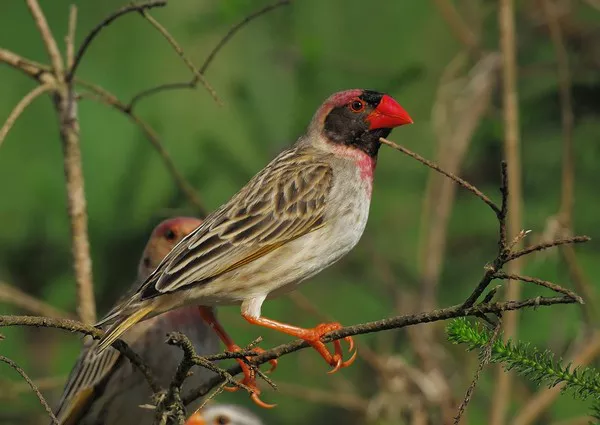Earth, with its rich biodiversity, hosts an incredible array of life forms, each contributing to the intricate balance of ecosystems. Some species, however, have achieved remarkable success in terms of abundance, adapting to diverse environments and thriving across the globe. In this exploration, we delve into the 10 most abundant animals on Earth, shedding light on the ecological significance of these prolific creatures and their unique adaptations that enable them to flourish.
10 Most Prolific Animals on the Planet
1. Red-Billed Quelea: A Sky Darkened by Millions
In the grasslands and savannas of sub-Saharan Africa, the red-billed quelea (Quelea quelea) stands out as one of the most abundant birds on the planet. These small, social birds form immense flocks that can number in the millions, creating mesmerizing murmurations that darken the sky. Feeding primarily on grains, their incredible numbers can have a significant impact on local ecosystems and agricultural landscapes.
2. Antarctic Krill: The Keystone of Southern Oceans
In the cold, nutrient-rich waters of the Southern Ocean, Antarctic krill (Euphausia superba) form the cornerstone of the marine food web. These small, shrimp-like crustaceans exist in colossal swarms, with estimates suggesting a total biomass in the hundreds of millions of tons. Krill play a vital role in transferring energy from phytoplankton to larger marine species, making them a linchpin in the delicate balance of polar ecosystems.
3. Army Ants: Nature’s Moving Swarm
Found in tropical rainforests across the globe, army ants (Ecitoninae) are known for their nomadic and highly social behavior. These relentless predators live in massive colonies, and when on the move, their numbers can reach into the millions. As they traverse the forest floor, army ants consume everything in their path, from insects to small vertebrates, making them a dominant force in their ecosystems.
4. Earthworms: Unsung Heroes of Soil Health
Beneath our feet, in the soil that sustains life, earthworms quietly contribute to the health of ecosystems. These unassuming annelids are found in a variety of habitats worldwide and are especially abundant in areas with rich, organic soil. Earthworms play a crucial role in nutrient cycling, soil aeration, and the breakdown of organic matter, making them essential for maintaining the fertility of agricultural and natural landscapes.
5. Mosquitoes: A Pervasive Presence with Consequences
Mosquitoes (Culicidae) are ubiquitous insects found in almost every corner of the globe, except for the most extreme environments. While their abundance is a testament to their adaptability, it comes with consequences. Mosquitoes are vectors for various diseases, including malaria, dengue fever, and Zika virus, impacting human and animal populations. Understanding their ecology is crucial for managing the associated health risks.
6. Common Red Soldier Beetle: Blooms in the Fields
In meadows and gardens across Europe, the common red soldier beetle (Rhagonycha fulva) is a familiar sight during the summer months. These beetles, also known as bloodsuckers, are abundant pollinators, visiting a variety of flowers for nectar and pollen. Their bright red coloration serves as a warning to potential predators, and their abundance contributes to the pollination of numerous plant species.
7. Copepods: Oceanic Microcosm Engineers
Copepods, small crustaceans found in marine environments, are the unsung heroes of the oceans. These tiny creatures play a crucial role in marine food webs, serving as a primary food source for many marine organisms, including fish larvae and whales. Their abundance in the open ocean highlights their importance in sustaining the productivity of marine ecosystems.
8. Brown Rats: Urban Survivors
As human settlements expanded globally, brown rats (Rattus norvegicus) followed, establishing themselves as some of the most successful urban adaptors. These rodents thrive in diverse environments, from bustling city centers to remote islands. While their presence often elicits negative reactions, brown rats contribute to ecosystem dynamics by serving as prey for various predators and scavengers.
9. Plankton: Microscopic Powerhouses of the Oceans
In the vast expanse of the world’s oceans, plankton reign supreme in terms of abundance. These microscopic organisms, including phytoplankton and zooplankton, form the foundation of marine food webs. Phytoplankton, through photosynthesis, produces oxygen and serves as the base of the marine food chain, while zooplankton sustains larger marine life. The sheer quantity of plankton underscores their critical role in supporting oceanic life.
10. Common Starling: A Global Avian Success Story
Native to Eurasia, the common starling (Sturnus vulgaris) has become one of the most widespread and abundant bird species on Earth. Flocks of starlings, known for their mesmerizing aerial displays, have successfully colonized various continents, including North America and Australia. Their adaptability to diverse habitats, from urban areas to agricultural landscapes, has contributed to their global success.
See Also:10 MOST BEAUTIFUL BIG CATS IN THE WORLD
Conclusion:
The abundance of these 10 species reflects their remarkable adaptability and ecological significance in diverse ecosystems around the world. While some play pivotal roles in nutrient cycling and ecosystem health, others, like mosquitoes, have complex relationships with human societies, impacting public health. Recognizing the importance of these abundant animals is essential for understanding the intricate web of life on Earth and fostering a balanced coexistence between humans and the myriad species that share our planet.
You Might Be Interested In:























